We all are aware of the most popular command called ‘useradd‘ or ‘adduser‘ in Linux. There are times when a Linux System Administrator is asked to create user accounts on Linux with some specific properties, limitations, or comments.
[ You might also like: How to Create a Shared Directory for All Users in Linux ]
In Linux, a ‘useradd‘ command is a low-level utility that is used for adding/creating user accounts in Linux and other Unix-like operating systems. The ‘adduser‘ is much similar to the useradd command because it is just a symbolic link to it.

In some other Linux distributions, the useradd command may come with a slightly different version. I suggest you read your documentation, before using our instructions to create new user accounts in Linux.
When we run the ‘useradd‘ command in the Linux terminal, it performs the following major things:
- It edits /etc/passwd, /etc/shadow, /etc/group, and /etc/gshadow files for the newly created user accounts.
- Creates and populates a home directory for the new user.
- Sets permissions and ownerships to the home directory.
Useradd Command Syntax
The Basic syntax of the useradd command is:
# useradd [options] username
In this article, we will show you the most used 15 useradd commands with their practical examples in Linux. We have divided the section into two parts from Basic to Advance usage of the command.
- Part I: Basic Useradd Commands with 10 examples
- Part II: Advance Useradd Commands with 5 examples
1. How to Add a New User in Linux
To add/create a new user, you’ve to follow the command ‘useradd‘ or ‘adduser‘ with ‘username‘. The ‘username‘ is a user login name, that is used by a user to login into the system.
Only one user can be added and that username must be unique (different from other usernames that already exist on the system).
For example, to add a new user called ‘tecmint‘, use the following command.
[root@tecmint ~]# useradd tecmint
When we add a new user in Linux with the ‘useradd‘ command it gets created in a locked state and to unlock that user account, we need to set a password for that account with the ‘passwd‘ command.
[root@tecmint ~]# passwd tecmint Changing password for user tecmint. New UNIX password: Retype new UNIX password: passwd: all authentication tokens updated successfully.

Once a new user is created, its entry is automatically added to the ‘/etc/passwd‘ file. The file is used to store the user’s information and the entry should be.
tecmint:x:1000:1000:tecmint:/home/tecmint:/bin/bash

The above entry contains a set of seven colon-separated fields, each field has its own meaning. Let’s see what are these fields:
- Username: User login name used to login into the system. It should be between 1 to 32 characters long.
- Password: User password (or x character) stored in /etc/shadow file in an encrypted format.
- User ID (UID): Every user must have a User ID (UID) User Identification Number. By default, UID 0 is reserved for the root user and UIDs ranging from 1-99 are reserved for other predefined accounts. Further UIDs ranging from 100-999 are reserved for system accounts and groups.
- Group ID (GID): The primary Group ID (GID) Group Identification Number stored in the /etc/group file.
- User Info: This field is optional and allows you to define extra information about the user. For example, the user’s full name. This field is filled by the ‘finger’ command.
- Home Directory: The absolute location of the user’s home directory.
- Shell: The absolute location of a user’s shell i.e. /bin/bash.
2. Create a User with a Different Home Directory
By default ‘useradd‘ command creates a user’s home directory under /home directory with a username. Thus, for example, we’ve seen above the default home directory for the user ‘tecmint‘ is ‘/home/tecmint‘.
However, this action can be changed by using the ‘-d‘ option along with the location of the new home directory (i.e. /data/projects). For example, the following command will create a user ‘anusha‘ with a home directory ‘/data/projects‘.
[root@tecmint ~]# useradd -d /data/projects anusha [root@tecmint ~]# passwd anusha
You can see the user’s home directory and other user-related information like user id, group id, shell, and comments.
[root@tecmint ~]# cat /etc/passwd | grep anusha anusha:x:1001:1001::/data/projects:/bin/bash

3. Create a User with a Specific User ID
In Linux, every user has their own UID (Unique Identification Number). By default, whenever we create a new user account in Linux, it assigns userid 500, 501, 502, and so on…
But, we can create users with custom userid with the ‘-u‘ option. For example, the following command will create a user ‘navin‘ with custom userid ‘1002‘.
[root@tecmint ~]# useradd -u 1002 navin
Now, let’s verify that the user created with a defined userid (1002) using the following command.
[root@tecmint ~]# cat /etc/passwd | grep navin navin:x:1002:1002::/home/navin:/bin/bash
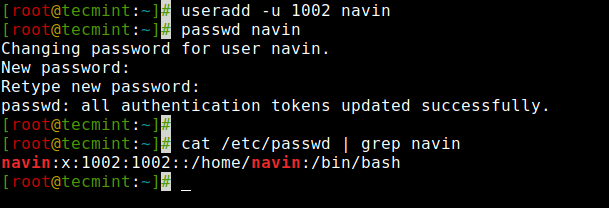
NOTE: Make sure the value of a user ID must be unique from any other already created users on the system.
4. Create a User with a Specific Group ID
Similarly, every user has their own GID (Group Identifier). We can create users with specific group IDs as well with the -g option.
Here in this example, we will add a user ‘tarunika‘ with a specific UID and GID simultaneously with the help of ‘-u‘ and ‘-g‘ options.
[root@tecmint ~]# useradd -u 1005 -g tecmint tarunika
Now, see the assigned user id and group id in the ‘/etc/passwd‘ file.
[root@tecmint ~]# cat /etc/passwd | grep tarunika tarunika:x:1005:1000::/home/tarunika:/bin/bash
To verify the user’s GID, use the id command:
[root@tecmint ~]# id -gn tarunika
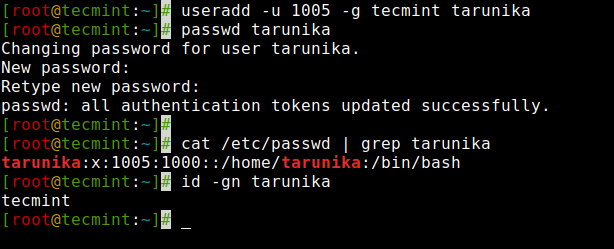
5. Add a User to Multiple Groups
The ‘-G‘ option is used to add a user to additional groups. Each group name is separated by a comma, with no intervening spaces.
Here in this example, we are adding a user ‘tecmint‘ into multiple groups like admins, webadmin, and developers.
[root@tecmint:~]# groupadd admins [root@tecmint:~]# groupadd webadmin [root@tecmint:~]# groupadd developers [root@tecmint:~]# usermod -a -G admins,webadmin,developers tecmint [root@tecmint:~]# useradd -G admins,webadmin,developers paddy
Next, verify that the multiple groups are assigned to the user with the id command.
[root@tecmint ~]# id tecmint uid=1000(tecmint) gid=1000(tecmint) groups=1000(tecmint),1007(admins),1008(webadmin),1009(developers) context=root:system_r:unconfined_t:SystemLow-SystemHigh

[ You might also like: How to Add or Remove a User from a Group in Linux ]
6. Add a User without Home Directory
In some situations, where we don’t want to assign home directories for a user, due to security reasons. In such a situation, when a user logs into a system that has just restarted, its home directory will be root. When such a user uses the su command, its login directory will be the previous user’s home directory.
To create users without their home directories, ‘-M‘ is used. For example, the following command will create a user ‘shilpi‘ without a home directory.
[root@tecmint ~]# useradd -M shilpi
Now, let’s verify that the user is created without a home directory, using the ls command.
[root@tecmint ~]# ls -l /home/shilpi ls: cannot access /home/shilpi: No such file or directory

7. Create a User with an Account Expiry Date
By default, when we add user’s with the ‘useradd‘ command user account never get expires i.e their expiry date is set to 0 (which means never expired).
However, we can set the expiry date using the ‘-e‘ option, which sets the date in YYYY-MM-DD format. This is helpful for creating temporary accounts for a specific period of time.
[ You might also like: How to Manage User Password Expiration and Aging in Linux ]
Here in this example, we create a user ‘aparna‘ with an account expiry date i.e. 27th August 2021 in YYYY-MM-DD format.
[root@tecmint ~]# useradd -e 2021-08-27 aparna
Next, verify the age of the account and password with the ‘chage‘ command for user ‘aparna‘ after setting the account expiry date.
[root@tecmint ~]# chage -l aparna Last password change : Jun 25, 2021 Password expires : never Password inactive : never Account expires : Aug 27, 2021 Minimum number of days between password change : 0 Maximum number of days between password change : 99999 Number of days of warning before password expires : 7

8. Create a User with Password Expiry Date
The ‘-f‘ argument is used to define the number of days after a password expires. A value of 0 inactive the user account as soon as the password has expired. By default, the password expiry value set to -1 means never expires.
Here in this example, we will set an account password expiry date i.e. 45 days on a user ‘mansi‘ using ‘-e‘ and ‘-f‘ options.
[root@tecmint ~]# useradd -e 2014-04-27 -f 45 mansi

9. Add a User with Custom Comments
The ‘-c‘ option allows you to add custom comments, such as the user’s full name, phone number, etc to /etc/passwd file. The comment can be added as a single line without any spaces.
For example, the following command will add a user ‘mansi‘ and would insert that user’s full name, Manis Khurana, into the comment field.
[root@tecmint ~]# useradd -c "Manis Khurana" mansi
You can see your comments in the ‘/etc/passwd‘ file in the comments section.
[root@tecmint ~]# tail -1 /etc/passwd mansi:x:1010:1013:Manis Khurana:/home/mansi:/bin/sh

10. Create a User Login Shell in Linux
Sometimes, we add users who have nothing to do with the login shell or sometimes we require to assign different shells to our users. We can assign different login shells to each user with the ‘-s‘ option.
Here in this example, will add a user ‘tecmint‘ without a login shell i.e. ‘/sbin/nologin‘ shell.
[root@tecmint ~]# useradd -s /sbin/nologin tecmint
You can check the assigned shell to the user in the ‘/etc/passwd‘ file.
[root@tecmint ~]# tail -1 /etc/passwd tecmint:x:1011:1014::/home/tecmint:/sbin/nologin

11. Add a User with a Specific Home Directory, Default Shell, and Custom Comment
The following command will create a user ‘ravi‘ with home directory ‘/var/www/tecmint‘, default shell /bin/bash and adds extra information about the user.
[root@tecmint ~]# useradd -m -d /var/www/ravi -s /bin/bash -c "TecMint Owner" -U ravi

In the above command ‘-m -d‘ option creates a user with a specified home directory and the ‘-s‘ option sets the user’s default shell i.e. /bin/bash. The ‘-c‘ option adds extra information about the user and the ‘-U‘ argument creates/adds a group with the same name as the user.
12. Add a User with Home Directory, Custom Shell, Custom Comment, and UID/GID
The command is very similar to the above, but here we define shell as ‘/bin/zsh‘ and custom UID and GID to a user ‘tarunika‘. Where ‘-u‘ defines the new user’s UID (i.e. 100) and whereas ‘-g‘ defines GID (i.e. 1000).
[root@tecmint ~]# useradd -m -d /var/www/tarunika -s /bin/zsh -c "TecMint Technical Writer" -u 1000 -g 100 tarunika

13. Add a User with Home Directory, No Shell, Custom Comment, and User ID
The following command is very much similar to the above two commands, the only difference is here, that we disabled the login shell to a user called ‘avishek‘ with a custom User ID (i.e. 1019).
Here ‘-s‘ option adds the default shell /bin/bash, but in this case, we set a login to ‘/usr/sbin/nologin‘. That means user ‘avishek‘ will not able to login into the system.
[root@tecmint ~]# useradd -m -d /var/www/avishek -s /usr/sbin/nologin -c "TecMint Sr. Technical Writer" -u 1019 avishek

14. Add a User with Home Directory, Shell, Custom Skell/Comment, and User ID
The only change in this command is, we used the ‘-k‘ option to set the custom skeleton directory i.e. /etc/custom.skell, not the default one /etc/skel. We also used the ‘-s‘ option to define different shells i.e. /bin/tcsh to user ‘navin‘.
[root@tecmint ~]# useradd -m -d /var/www/navin -k /etc/custom.skell -s /bin/tcsh -c "No Active Member of TecMint" -u 1027 navin

15. Add a User without Home Directory, No Shell, No Group, and Custom Comment
The following command is very different than the other commands explained above. Here we used the ‘-M‘ option to create a user without the user’s home directory and the ‘-N‘ argument is used that tells the system to only create a username (without group). The ‘-r‘ argument is for creating a system user.
[root@tecmint ~]# useradd -M -N -r -s /bin/false -c "Disabled TecMint Member" clayton

For more information and options about useradd, run the ‘useradd‘ command on the terminal to see available options.
# useradd
[ You might also like: 15 Useful Usermod Command Examples in Linux ]


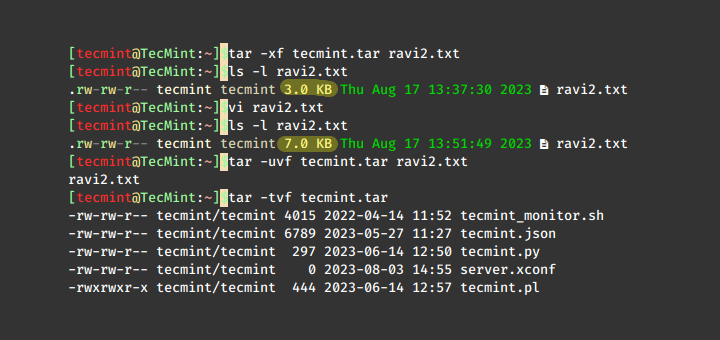

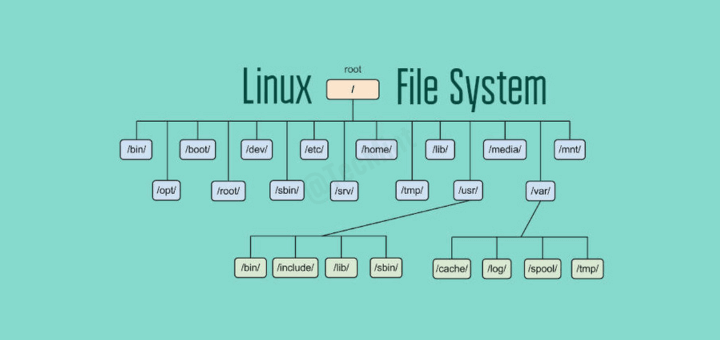

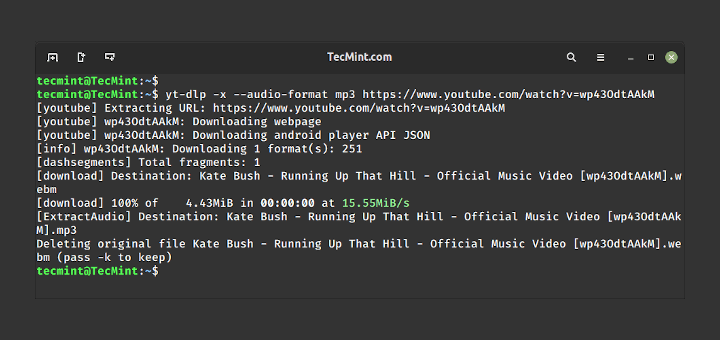
Section 3. Create a User with Specific User ID – >
With reference to this statement – “By default, whenever we create a new user accounts in Linux, it assigns userid 500, 501, 502 and so on…”
Doesn’t Linux create a new user and assign UID to new users by default from – 1001, 1002, 1003 … onwards, instead of 500 ?
“Doesn’t Linux create a new user and assign UID to new users by default from – 1001, 1002, 1003 … onwards, instead of 500 ?”
Depends on the distro. Some start at 500. It is also possible to change the starting number to almost anything you please, as long as the user numbers do not conflict with preset root/system numbers.
Thanks, nice tips
Hi,
Can you please tell us to how to create a user with password in single command line on Debian
Thank you.
Yogesh
@Yogesh,
I hope this following command will help you to add user and password with one single command.
I cannot get the ‘adduser‘ or ‘useradd‘ commands to work. Whenever I try I get the prompt “bash: useradd: command not found”
@Ray,
First, locate the useradd location using:
Then, try adding /usr/sbin to your path.
Thanks again for your response.
Quick question- If the user joins signs in/out the following day, it will be the closet possible date of creation – correct?
e.g. I created user john on Jan 30 and the sign joins organization on Jan 31 and signs in/out, this is when .bash_logout will be created -correct?
Thanks
I created a new user and it came up with some results, not so relevant to the user creation date. However, it seems like showing me authentication success or failure for the user.
Any further ideas?
@Harry,
To find out correct user creation date in Linux, you need to check the stats of
.bash_logoutfile in your home directory.Sample Output
In the output above highlighted, shows the correct user creation date..
I installed and run without any luck. It returned no results. I double-checked
/etc/passwdto confirm if the user I am testing with existed.I checked the status and restarted the service auditd.
Is there anything I am missing?
Thanks
@Harry,
You just installed auditd, so it will not track existing users. Try to create a new user and see..
Hey,
How can I create a user which shows the date of creation (date stamp) so that IS security can audit it, down the road. It would be great if it is for RHEL or Ubuntu distros.
Thanks
@Harry,
To Find Out When a User is Created in Linux, you can check the stat of
.bash_logoutfile, as this file is created upon the user’s first logout.Thank you for your quick response.
At work, I have a scenario where we generally create a user a day in advance of his joining date. If I follow, what you said I can get approximation and not exact date as a user will log in and logout the following day. However, our IS security team wants to know the time stamp of user creation or their audit. Do you recommend any other way to know the creation date?
@Harry,
If you have auditd installed on the system, you can find out the user creation date and time.
Alternatively, you can find the user creation in /var/log/secure file..
I am not able to set a password for a new user, it shows heading New password but it does not type anything neither any alphabetical letter nor a number.
Please help me.
Example 5)
if the user is already exit command should be:
If you are adding the new user to additional groups then command:
is correct…